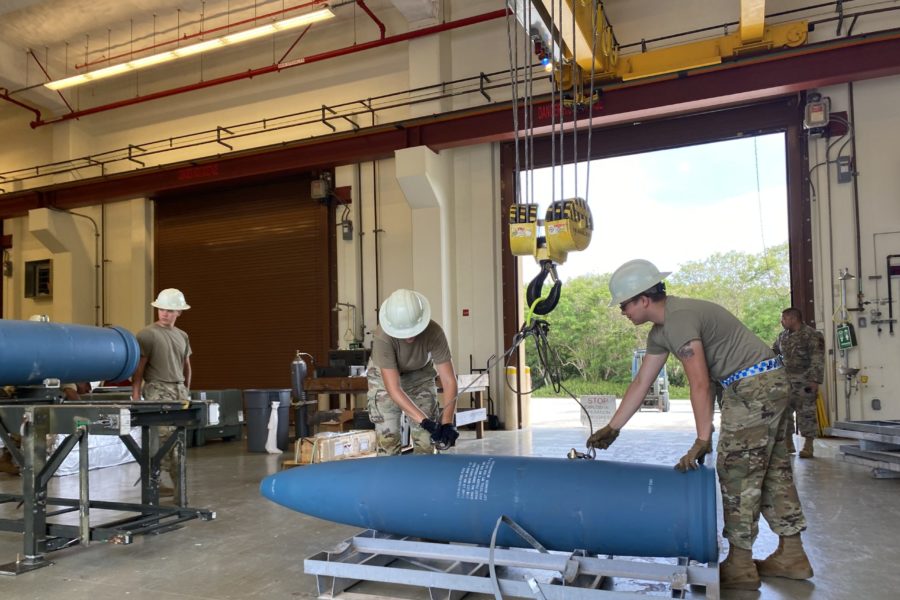ANDERSEN AIR FORCE BASE, Guam—Amid 4,400 acres of jungle terrain on the northern plateau of Guam, new construction is underway to add storage for standoff munitions and to better prepare the Air Force to meet the rising threat posed by China.
The new standoff weapons complex under construction at the Air Force’s largest munitions depot in the world will cost $43.7 million and include 20 Hayman-style igloos capable of storing 48 pre-loaded standoff weapons, plus a pre-load facility and a powered trailer capable of fully equipping bombs.
“We need more storage space,” said Maj. Timothy Wu, commander of the 36th Munitions Squadron at Andersen Air Force Base, Guam.
Wu is responsible for $1.7 billion in munitions inventory consisting of 17.1 million pounds of explosive weight. Current igloos, including 1950s-era magazines covered in dirt and grass, are 90 percent occupied and increasingly filling. Aside from invasive deer, wild boar, brown snakes, and packs of dogs that roam the site, munitions handlers battle an aggressive equatorial environment that includes typhoons and high humidity, inducing corrosion.

Andersen’s munitions storage is already extensive, including 127 earth-covered igloos, four flow-through igloos, 10 above-ground magazines, two eight-bay multi-cubes, 152 open-storage pads, and eight explosive operation locations.
With new Joint Air-to-Surface Standoff Missiles (JASSM) coming online to protect the continental United States from Guam’s “forward edge” location, the U.S. Air Force needs a strategically located storage facility to equip bombers for forward positioning away from the West Coast of the mainland.
“We are in the area where China is concerned about,” he added. “This is what we can do to support future bombers—and, of course, current bombers.”
The facilities will allow the 36th MUNS to pre-load JASSMs in place of current assembly process, cutting load times from eight hours to just two hours.
“That way, whenever bombers come out here, they can be rapidly reloaded right away,” Wu explained.
Joint Region Marianas (JRM) commander Rear Adm. Benjamin Nicholson, who oversees the Navy, Marine Corps, and about half the functions at Andersen, said new ordnance types and service needs, as well as future plans for defense of the island, require a quick ramp-up in storage capacity.

“As more forces pivot towards the Pacific, we’ve also had some interest from some other services in having some magazine storage capability here,” Nicholson told Air Force Magazine at the JRM headquarters at Fonte Plateau, the site of the 1944 Marine Corps charge that retook Guam from Imperial Japan.
The Army and Marine Corps will also be adding munitions in Guam.
Marine Corps Camp Blaz is undergoing extensive expansion on the northern part of Guam that will add barracks to accommodate 5,000 Marines. Jungle operations training, an urban warfare training area, and firing ranges will also be coming online in the next two years.
Perhaps most important for the defense of Guam will be the munitions stored by the Missile Defense Agency as Terminal High Altitude Area Defense (THAAD) units are enhanced by Patriot missile defense systems and Indirect Fire Protection Capability (IFPC) missile interceptors.
The 20 new igloos are part of Phase 3 of a four-phase expansion plan, said Wu. A $49 million contract recently awarded for completion of Phase 4 will add 16 more igloos by 2024 and ready Guam to support the newest bomber platforms.
“All those bomber bases already have that type of facility, so that’s just building this capability here,” explained Wu, noting that the new facilities will position Guam for second-strike capability.
“The reason why we have this that way is so that we can rapidly reload bomber aircraft. When they land here, they can get rapidly re-armed and take back off again,” he said. “It increases the lethality for a second strike.”


